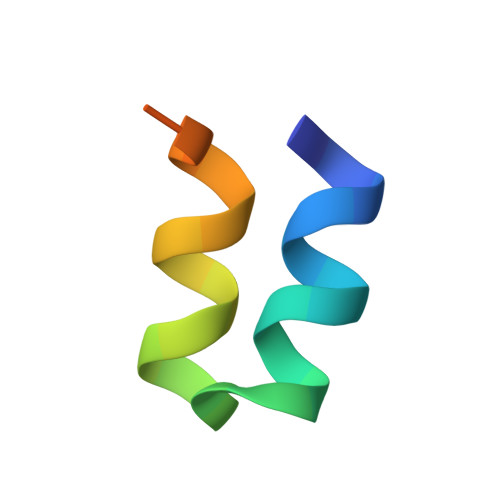The complete influenza hemagglutinin fusion domain adopts a tight helical hairpin arrangement at the lipid:water interface.
Lorieau, J.L., Louis, J.M., Bax, A.(2010) Proc Natl Acad Sci U S A 107: 11341-11346
- PubMed: 20534508
- DOI: https://doi.org/10.1073/pnas.1006142107
- Primary Citation of Related Structures:
2KXA - PubMed Abstract:
All but five of the N-terminal 23 residues of the HA2 domain of the influenza virus glycoprotein hemagglutinin (HA) are strictly conserved across all 16 serotypes of HA genes. The structure and function of this HA2 fusion peptide (HAfp) continues to be the focus of extensive biophysical, computational, and functional analysis, but most of these analyses are of peptides that do not include the strictly conserved residues Trp(21)-Tyr(22)-Gly(23). The heteronuclear triple resonance NMR study reported here of full length HAfp of sero subtype H1, solubilized in dodecylphosphatidyl choline, reveals a remarkably tight helical hairpin structure, with its N-terminal alpha-helix (Gly(1)-Gly(12)) packed tightly against its second alpha-helix (Trp(14)-Gly(23)), with six of the seven conserved Gly residues at the interhelical interface. The seventh conserved Gly residue in position 13 adopts a positive angle, enabling the hairpin turn that links the two helices. The structure is stabilized by multiple interhelical C(alpha)H to C=O hydrogen bonds, characterized by strong interhelical H(N)-H(alpha) and H(alpha)-H(alpha) NOE contacts. Many of the previously identified mutations that make HA2 nonfusogenic are also incompatible with the tight antiparallel hairpin arrangement of the HAfp helices.(15)N relaxation analysis indicates the structure to be highly ordered on the nanosecond time scale, and NOE analysis indicates HAfp is located at the water-lipid interface, with its hydrophobic surface facing the lipid environment, and the Gly-rich side of the helix-helix interface exposed to solvent.
Organizational Affiliation:
Laboratory of Chemical Physics, National Institute of Diabetes and Digestive and Kidney Diseases, National Institutes of Health, Bethesda, MD 20892, USA.
















